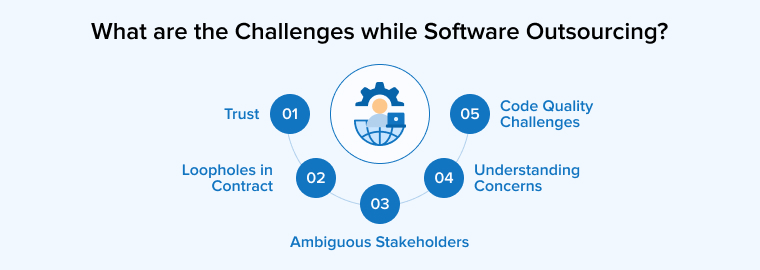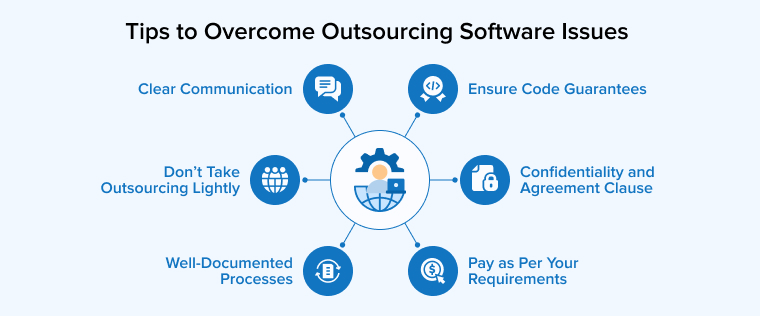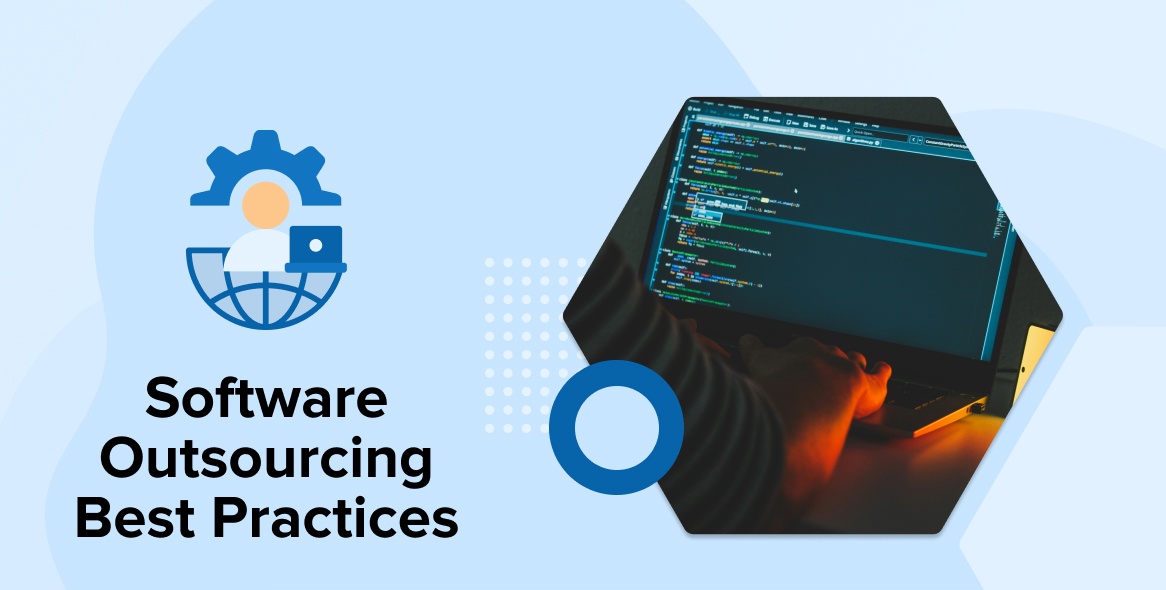
Access to world-class talent, cost-effectiveness, and improved business results are some of the strong reasons for Outsourcing software development projects. Companies are more inclined to outsource software development to aid these benefits. It is quite evident that this segment is burgeoning and has reached a market size of 92.6 $ BN. Hence, we can ensure that it is a profitable affair. You can always take up software outsourcing for your business if you are thorough with the process of outsourcing. In this blog, we elaborate on the challenges while software outsourcing and tips to overcome these challenges.
What if your competitor is already leveraging the benefits of software outsourced software development? You might be under the wrong impression of losing something that adds value to your business. If yes then don’t be overshadowed by problems occurring during the process. Many third-party software development partners assure you of qualitative and timely deliverables, seamless business operation, and cost-effective solutions.
Software development Outsourcing is a very common phrase in the Software industry. In this blog, we will be taking a quick run-through on the understandings of Software Outsourcing, the stages of software process outsourcing, the software outsourcing challenges, and steps to overcome them.
So, let’s start our exploring the process of software development Outsourcing.
1. What is Software Development Outsourcing?
Software Development Outsourcing is the process of sourcing experts in custom software development services to outsourcing companies (or individuals challenges in this stage can) to focus on their core business.
Outsourcing, which can be found in all markets and businesses, has become a common part of life and industry. Clothing processing, for instance, is mostly outsourced to industries in Asia, America, and other geographies as well. Undoubtedly, Software development has joined a fray where it is becoming the most admired and sought-after service. This might grow consistently in the future as well.
2. Stages of Software Development Process

As we all know that software development is an elaborative process that contains several other smaller processes. This comprehensive process of software development is called SDLC- Software development life cycle. SDLC is a complete development cycle that involves multiple stages. It is mostly divided into smaller steps which include Planning, Requirements, Design, Building, Document, Test, Deploy, and Maintain. It is a sequential process which means after each step has been completed the next one is followed up.
All businesses need to understand all the phases of the software development life cycle to relate to what challenges each phase. Let us discuss each of these phases in detail to start with.
2.1 Planning Phase
This is the first phase of the software development life cycle project. Here you can create solutions for all real-world complications by developing an app using your software development skills. In this planning phase, the major stakeholders are the project managers. They decide everything from cost calculation, resources required, time and deliveries, projected deadlines, and time of launch. The planning of the scope of the project and the purpose of the development team are clearly defined in the first stage.
The challenges in this stage can be the absence of clear guidelines, unclear scope, unable to find the right resources or outsourcing company or even the development cost not fitting the budget, etc.
2.2 Requirement Gathering
In this stage, Business analysts play a strategic role. They plan and see which factors will be influential in this project and which will be not. You will have to gather all the necessary details from the planning phase and use them wisely in the plan.
Challenges in this stage include identifying the right resources as per their skillset, Making a precise plan that doesn’t have any setbacks. Detailed and precise information about project requirements is very essential for successful outsourcing. Here clients prepare an SRS document that is a specification of what a client wants in a format understood by the software development company and their development team.
2.3 Designing and Prototyping
In this third stage of software development, it is now time to actually design the software. During this designing phase, we customize the software based on the requirements and shape it as per the client’s demands. The main contributors in this area are the architecture of the application, the interface for users to use, and lastly the platform where we want the app to be used. Platforms are operating systems like android, iOS, or windows.
To avoid design challenges, you should imply prototyping as a part of the designing stage. It is an iterative approach that can be shown to clients as a model of what actually the developed application will look like. The improvements will be corrected before starting to develop a software project and hence it’s a cost-effective approach.
2.4 Software Development
This is the actual implementation phase where there is coding done, errors have been identified during the development process, performance or glitch monitoring, and source code management. There are many tasks lined up in this software development process that needs to be fixed, explained, and resolved. Most software outsourcing companies use agile methodology in software development.
There are many challenges that software developers may face like communication issues, understanding concerns, code errors, alignment of business development processes and developed features, non-documented challenges, and several other small and large issues of the software projects.
2.5 Testing
To make applications available for users without any glitches, it is important to timely monitor and tests the application for a seamless performance. We perform quality control of every feature, module, and then overall application and then perform other types of tests such as UAT, performance, functionality, etc. With this, the user experience of the application is improved.
In the quality assurance process, you would face functionality challenges while software outsourcing would need more time and effort. We might miss out on unexpected errors that were supposed to get resolved in this phase.
2.6 Deployment
Deployment is ideally the last and final stage and after this stage, the users will be using the application. You will be deploying the software applications in the planned environment and checking their functioning. You might encounter complications or hurdles if you haven’t integrated the database with the system appropriately.
After knowing all the phases now, it’s time for us to take a deeper look at the challenges while software outsourcing. Above we discussed issues regarding the SDLC life cycle when you decide to develop an app. Now we will be discussing all the possible doubts and challenges that businesses have when they decide to do software outsourcing.
3. What are the Challenges while Software Outsourcing?

When you decide to outsource your business to a third-party company, there are inflows of so many doubts, concerns, and issues. There are so many concerns generally that bother companies do not outsource their desired Software outsourcing business. Choosing the best country for software outsourcing is the biggest challenge.
Here are some of the major challenges software outsourcing that businesses face while they decide to outsource.
3.1 Trust
With multiple ways of outsourcing in the market, businesses are not sure of whom to trust and outsource. Trust can be extremely important in outsourcing relationships. One of the biggest benefits that software outsourcing offers to businesses is a large access to talented resources and cost-effectiveness. That’s not only the reason they outsource but there are a plethora of benefits that make them look for a software outsourcing partner. Develop your own communication tools to secure a healthy environment and build trustful outsourcing relationships.
Trust is one of the largest key factors that make businesses from all domains hesitant to outsource. Businesses do not have transparency and hence they have trust concerns when they outsource. It can be regarding the security or app, data breach, or any personal or vital data of the company.
3.2 Loopholes in Contract
Most of the time when a company develops trust in another company still many issues prevail. Issues such as no additional feature will be developed, extra charges for small glitches leaked private data of the company, and many more similar concerns.
Thus it is advisable to create a software agreement with no loopholes. Many times there are concerns with the contract created. NDA is necessary to safeguard the intellectual property rights of product owners. Businesses forget to include the essential terms and conditions and then regret later that. So the loopholes are a very critical concern when they decide to outsource.
3.3 Ambiguous Stakeholders
This is another important aspect that businesses do not outsource to companies they don’t know or have never collaborated with. After developing an app there are numerous challenges such as project ownership, inconsistency in deliveries, and no direct leader involved in the outsourcing process creates ambiguity in stakeholder expectations.
Also, inconsistency is one of the reasons businesses do not outsource. The resource team and the team of managers keep on changing which makes no one accountable completely for the development project.
3.4 Understanding Concerns
It is the first and basic step to understanding what the business owners expect. Not understanding the client’s needs and creating something else is a disadvantage for most businesses in terms of time, effort, and cost overruns.
3.5 Code Quality Challenges
Most of the time it happens that the apps stop performing. Definitely, no parameter signifies the quality of code like high or low. What will define whether the code is maintaining the quality of code when outsourcing is one of the important qualities. We can say adhering to standard practices and maintaining building a code that is durable and sustainable.
Code quality can be decided based on the best practices that a business follows to make its code quality work. So always follow a practice of good documentation and well-tested codes that makes the application highly performing and bug-free. It will be performing in the long-term association and will be among the top code challenges.
4. Tips to Overcome Issues while Outsourcing Software Development

Now that we know what challenges businesses face while outsourcing we have curated a list wherein with our experts who have dealt with global businesses. Their experience and expertise in custom software development teams have helped multiple business profits. So why not use these quick tricks to help businesses overcome the fear of outsourcing?
These six factors are essential to be noted and can be taken care of to plan wisely before outsourcing.
4.1 Don’t Take Outsourcing Lightly
The first step is to analyze whether your business will benefit from outsourcing or not. The immediate next step in the plan is to decide on whom to outsource. As we have seen Trust is one of the reasons businesses don’t outsource so for authenticity look for trusted sources of partners. Go for a reference from a peer company that has outsourced and see the results or searches on sites that provide a cumulative list of such third-party outsourcing companies. Read testimonials and decide.
It is not wise to take this process on a lighter note because many of them have faced loss by not being given the attention that it needs.
4.2 Pay as Per Your Requirements
You can discuss with the partner outsourcing company and select a method of “Pay as you go”. This means you will be paying when a specific module is done or a milestone of the project is achieved. This will make you satisfied and won’t have to pay a bulk amount in a go.
4.3 Code Guarantees
Most of the time businesses just check the code functionality during the time of deployment and once there are changes made the code stops functioning. Thus it is advisable to take code guarantees as acceptance criteria in case it stops working or the technology gets old with time so finding an alternative or suggesting one should be outsourcing the company’s suggestion.
4.4 Clear Communication
Communication is the key for most businesses and although most businesses are aware of it yet neglect this essential factor. Sometimes, language barriers have been seen as a challenge in hiring outsourced developers. Clear communication will help businesses resolve most of their barriers. It is not just a gap in communication but also miscommunication that creates a major challenge and makes the process complicated and cumbersome.
Therefore, it is always advised to keep clear communication and use all the technology advancements to keep track and take regular updates on the progress of the project. time zone issues may cause a major challenge in communication.
4.5 Well-Documented Processes
Another important step that many companies do not follow is to document the process of outsourced development. It is extremely important to document a process so that you don’t have to remember each step and just take steps according to the plan and accomplish key milestones.
A well-documented process is a guide that helps business understand their mistakes and even the growth plans of what worked well for them.
4.6 Confidentiality and Agreement Clause
A data breach or security rule break or information leakage is another set of reasons that prevent businesses from outsourcing. There is one master trick that would solve all these concerns of confidentiality and agreement. NDA- Non-Disclosure Agreement or Software Agreement will bind both these businesses together and help them for a long-term engagement without many disputes. NDA will also help in establishing a successful outsourcing partnership.
Include all necessary clauses, concede on points of dispute and make a confidentiality agreement that would make both the parties at peace.
5. Conclusion
Our elaborative research and professional experience in dealing with multiple clients from various geographic locations and domains have built this blog. We can help businesses coordinate with outsourcing companies and resolve their issues. With this blog, we tried to cover all aspects of the software outsourcing challenge and how to resolve them. Now the ball is in your court, take steps wisely.





Thank you for sharing such a awesome post. The challenges mentioned, such as trust issues, loopholes in contracts, and understanding concerns, are common in the outsourcing process. The tips provided, like not taking outsourcing lightly, clear communication, and well-documented processes, are practical and can help overcome these challenges. Overall, it's a valuable guide for businesses considering software outsourcing.